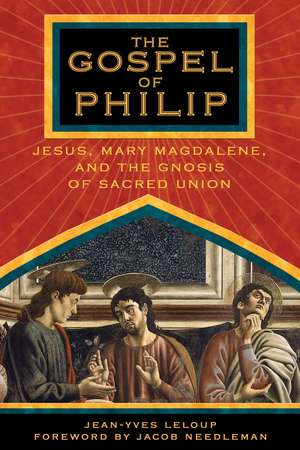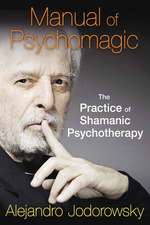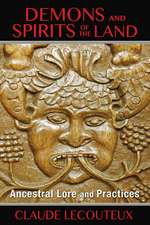The Gospel of Philip: Jesus, Mary Magdalene, and the Gnosis of Sacred Union
Autor Jean-Yves Leloup Cuvânt înainte de Jacob Needlemanen Limba Engleză Paperback – 16 aug 2004
Preț: 65.89 lei
Preț vechi: 88.26 lei
-25% Nou
Puncte Express: 99
Preț estimativ în valută:
12.61€ • 13.69$ • 10.59£
12.61€ • 13.69$ • 10.59£
Carte disponibilă
Livrare economică 04-16 aprilie
Preluare comenzi: 021 569.72.76
Specificații
ISBN-13: 9781594770227
ISBN-10: 1594770220
Pagini: 192
Ilustrații: 70 b&w illustrations
Dimensiuni: 152 x 229 x 13 mm
Greutate: 0.27 kg
Ediția:Us.
Editura: Inner Traditions/Bear & Company
Colecția Inner Traditions
Locul publicării:United States
ISBN-10: 1594770220
Pagini: 192
Ilustrații: 70 b&w illustrations
Dimensiuni: 152 x 229 x 13 mm
Greutate: 0.27 kg
Ediția:Us.
Editura: Inner Traditions/Bear & Company
Colecția Inner Traditions
Locul publicării:United States
Notă biografică
Jean-Yves Leloup an Orthodox theologian and professor of theology, philosophy, and psychology, is the founder of the International College of Therapists. His other books include The Gospel of Mary Magdalene and a forthcoming translation and commentary on the Gospel of Thomas. He lives in France.
Extras
Introduction
The Gospel of Philip
Most of the books of the Nag Hammadi Codices are Coptic translations of Greek originals. The Gospel of Philip is a part of Codex II. This codex is the most voluminous manuscript in the library of Khenoboskion. In addition to the Gospel of Philip, it contains the Gospel of Thomas, a version of the Apocryphon of John, the Hypostasis of the Archons, an anonymous writing known as “The Untitled Text” (and sometimes as "The Origin of the World"), the Exegesis on the Soul, and the Book of Thomas the Contender.
The Gospel of Philip was inserted between the Gospel of Thomas and the Hypostasis of the Archons. A photographic edition of the entire Codex II was published in 1956 and is housed at the Coptic Museum in Old Cairo. The Gospel of Philip is presented on plates 99-134. A first translation was made in 1960 by H.M. Schenke, who divided this Gospel into twenty-seven paragraphs. Although this division has been debated (E. Segelberg, R.M. Grant, J.E. Ménard), we have found it useful for this edition. It presents the Gospel of Philip as a kind of garland of words, no less enigmatic than those of the Gospel of Thomas, and more elaborate, because they are certainly of a later date than the latter.
The first pagination given at the tops of certain pages is that of the Codex, and the second is that of the photographic plates. We have also found it useful to employ a special numbering of the passages from 1 to 127, so as to facilitate references to logia.
It would be hard to overemphasize the difficulties involved in the translation from the Coptic of these often sibylline texts. Our concern has always been to find a meaning in these logia, even if it sometimes requires a departure from philological literalism. An archeologist is only required to make an inventory of the broken fragments of the vase; but the hermeneutist must at least imagine, if not establish, how the vase was used.
We have learned that to translate is always to interpret. This is where the "passion" of a text lies. The text is subject to our interpretation, and is itself a kind of decoding which always involves the subjectivity of a Logos which has been heard, or perhaps only thought. We still do not know what Yeshua really said. We only know what a number of hearers and witnesses have heard. Scripture consists of what has been heard, not of what has been said.
The Sacred Embrace, Conception, and Birth
All those who are begotten in the world are begotten by physical means, and the others are begotten by spiritual means.
Again, the resonances between this Gospel and the later Jewish tradition are striking. The physical act of love harbors a secret which has serious implications for the whole problem of a "chosen" or "holy" people, or a Kingdom of God. And the question of our possible membership in such an elect turns out to have nothing to do with what family or ethnicity we belong to. Instead, it has to do with the quality of trust and consciousness in the embrace, which makes us children of the nuptial act, icons of the Union.
Yet at the origins of Christianity, in the heart of the Jewish communities from which it arose, another voice had made itself heard:
The mystery which unites two beings is great;
without this union the world would not exist.
(Philip, logion 60:2-3)
That passage from Philip resonates with the Biblical tradition: in the beginning, as Genesis says, YHWH created male and female in his own image. Hence it is neither man nor woman that is in the image of God, but the relation between them.
Erotic love would thus appear to be a desperate yearning for one's missing half. However, the goal of a sexual relationship is not merely to regain our missing half, thereby gaining access to individuation, or to our original androgynous nature. The half which seeks its other half is really a kind of self-love; there is no access to otherness here, only a sort of inward differentiation, which is deemed painful and unfortunate.
In the Hebrew tradition, as in the Gospel of Philip, Love is more of a seeking of one wholeness for another wholeness. It is not born of lack, of penia, but of pleroma, an overflowing toward otherness.
A human being is born either male of female, but he or she must become a man or a woman--not just mature biologically, but become a Person, a Subject capable of meeting another Person or Subject, in a Love that is not needy or demanding. Trust and consciousness in the embrace is the echo of this Love.
Certain authors of the Hebrew tradition trace this encounter all the way back to two beings who are sexually differentiated, but share a single soul, or a single breath, before birth itself. This is a metaphysical way of emphasizing the fact that we were created to form a couple, through which we experience the epiphany of the Presence (Shekhina) of YHWH.
Thus in both the Jewish tradition and in the Gospel of Philip, the love relationship is not to be used for one's own fulfillment, for the relationship itself is our own fulfillment, and the revelation of a Third Term of Love, between Lover and Beloved. This Third Term is the source of differentiation as well as of union. The Biblical tradition calls it God, and the Evangelical tradition calls it Pneuma, or the Holy Spirit, the Breath which unites two beings.
This theme of the union of two breaths turns out to be especially important in the Gospel of Philip.
The Gospel of Philip
Most of the books of the Nag Hammadi Codices are Coptic translations of Greek originals. The Gospel of Philip is a part of Codex II. This codex is the most voluminous manuscript in the library of Khenoboskion. In addition to the Gospel of Philip, it contains the Gospel of Thomas, a version of the Apocryphon of John, the Hypostasis of the Archons, an anonymous writing known as “The Untitled Text” (and sometimes as "The Origin of the World"), the Exegesis on the Soul, and the Book of Thomas the Contender.
The Gospel of Philip was inserted between the Gospel of Thomas and the Hypostasis of the Archons. A photographic edition of the entire Codex II was published in 1956 and is housed at the Coptic Museum in Old Cairo. The Gospel of Philip is presented on plates 99-134. A first translation was made in 1960 by H.M. Schenke, who divided this Gospel into twenty-seven paragraphs. Although this division has been debated (E. Segelberg, R.M. Grant, J.E. Ménard), we have found it useful for this edition. It presents the Gospel of Philip as a kind of garland of words, no less enigmatic than those of the Gospel of Thomas, and more elaborate, because they are certainly of a later date than the latter.
The first pagination given at the tops of certain pages is that of the Codex, and the second is that of the photographic plates. We have also found it useful to employ a special numbering of the passages from 1 to 127, so as to facilitate references to logia.
It would be hard to overemphasize the difficulties involved in the translation from the Coptic of these often sibylline texts. Our concern has always been to find a meaning in these logia, even if it sometimes requires a departure from philological literalism. An archeologist is only required to make an inventory of the broken fragments of the vase; but the hermeneutist must at least imagine, if not establish, how the vase was used.
We have learned that to translate is always to interpret. This is where the "passion" of a text lies. The text is subject to our interpretation, and is itself a kind of decoding which always involves the subjectivity of a Logos which has been heard, or perhaps only thought. We still do not know what Yeshua really said. We only know what a number of hearers and witnesses have heard. Scripture consists of what has been heard, not of what has been said.
The Sacred Embrace, Conception, and Birth
All those who are begotten in the world are begotten by physical means, and the others are begotten by spiritual means.
Again, the resonances between this Gospel and the later Jewish tradition are striking. The physical act of love harbors a secret which has serious implications for the whole problem of a "chosen" or "holy" people, or a Kingdom of God. And the question of our possible membership in such an elect turns out to have nothing to do with what family or ethnicity we belong to. Instead, it has to do with the quality of trust and consciousness in the embrace, which makes us children of the nuptial act, icons of the Union.
Yet at the origins of Christianity, in the heart of the Jewish communities from which it arose, another voice had made itself heard:
The mystery which unites two beings is great;
without this union the world would not exist.
(Philip, logion 60:2-3)
That passage from Philip resonates with the Biblical tradition: in the beginning, as Genesis says, YHWH created male and female in his own image. Hence it is neither man nor woman that is in the image of God, but the relation between them.
Erotic love would thus appear to be a desperate yearning for one's missing half. However, the goal of a sexual relationship is not merely to regain our missing half, thereby gaining access to individuation, or to our original androgynous nature. The half which seeks its other half is really a kind of self-love; there is no access to otherness here, only a sort of inward differentiation, which is deemed painful and unfortunate.
In the Hebrew tradition, as in the Gospel of Philip, Love is more of a seeking of one wholeness for another wholeness. It is not born of lack, of penia, but of pleroma, an overflowing toward otherness.
A human being is born either male of female, but he or she must become a man or a woman--not just mature biologically, but become a Person, a Subject capable of meeting another Person or Subject, in a Love that is not needy or demanding. Trust and consciousness in the embrace is the echo of this Love.
Certain authors of the Hebrew tradition trace this encounter all the way back to two beings who are sexually differentiated, but share a single soul, or a single breath, before birth itself. This is a metaphysical way of emphasizing the fact that we were created to form a couple, through which we experience the epiphany of the Presence (Shekhina) of YHWH.
Thus in both the Jewish tradition and in the Gospel of Philip, the love relationship is not to be used for one's own fulfillment, for the relationship itself is our own fulfillment, and the revelation of a Third Term of Love, between Lover and Beloved. This Third Term is the source of differentiation as well as of union. The Biblical tradition calls it God, and the Evangelical tradition calls it Pneuma, or the Holy Spirit, the Breath which unites two beings.
This theme of the union of two breaths turns out to be especially important in the Gospel of Philip.
Cuprins
List of Abbreviations
Foreword by Jacob Needleman
Introduction
THE GOSPEL OF PHILIP
Recenzii
“In this rich and lucid translation, Jean-Yves Leloup unlocks mysteries of the enigmatic bridal chamber found in the Gospel of Philip and sheds new light on their associations with Jewish esoteric tradition.”
“For scholars and seekers alike, every page of this book opens profound new dimensions in the teachings of Jesus.”
"This book displays new and profound facets and dimensions in the teachings of Jesus."
“For scholars and seekers alike, every page of this book opens profound new dimensions in the teachings of Jesus.”
"This book displays new and profound facets and dimensions in the teachings of Jesus."
Descriere
A new translation and analysis of one of the most controversial of the apocryphal gospels.












